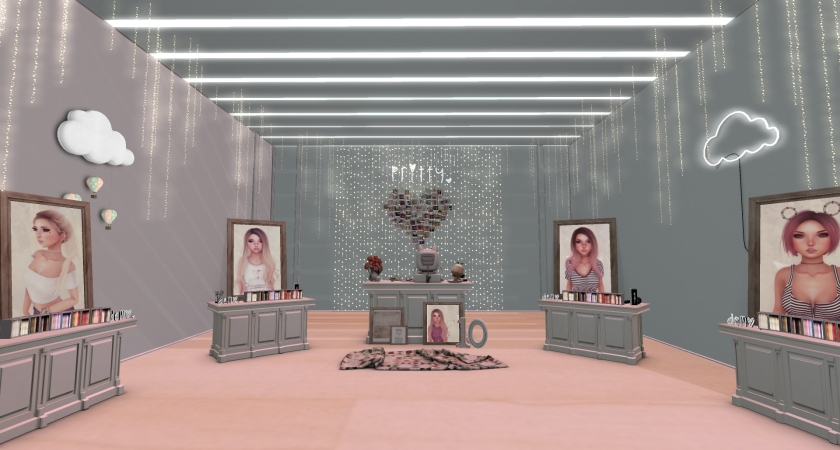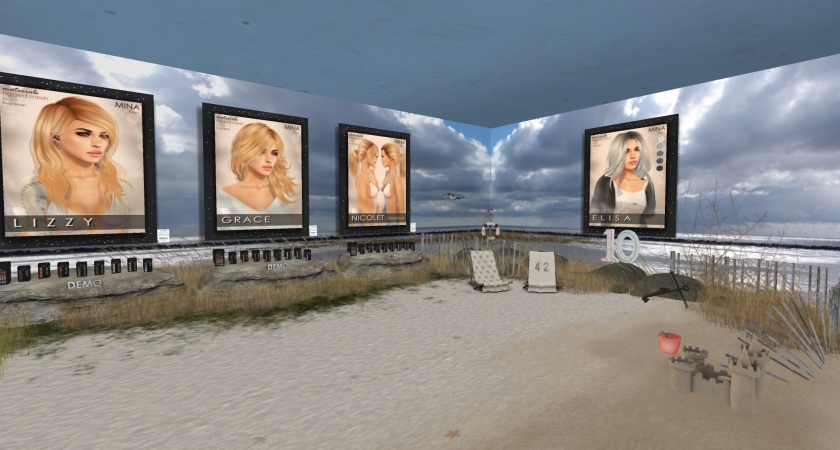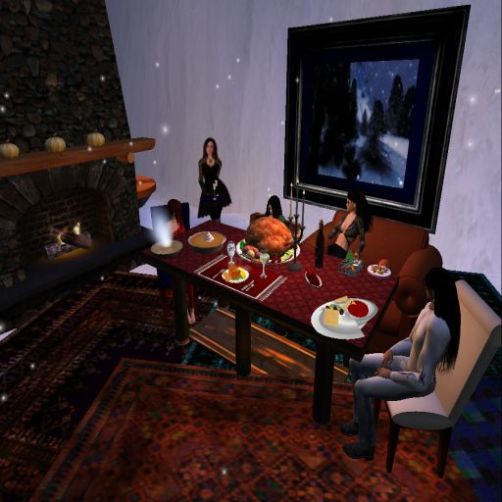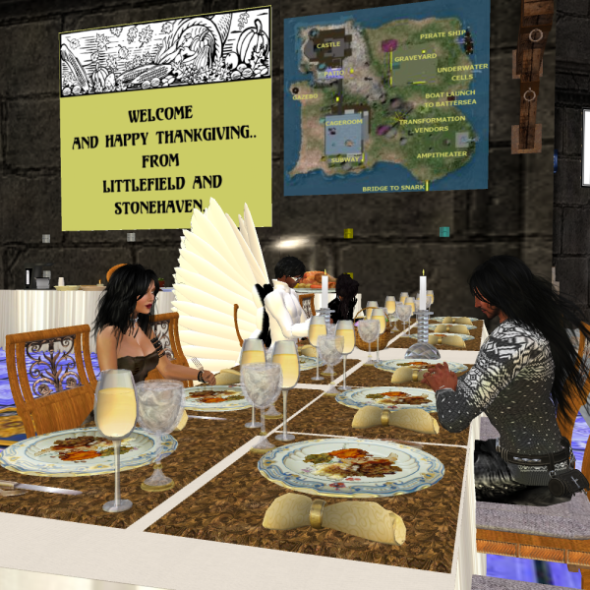Challenged by friends, I set out to answer the question: “Why do I love Nine Inch Nails?”
It is a puzzling question, for sure. Anyone who knows me would never guess my favorite band. I am a classical musician by training, and a quiet person by nature. Even more puzzling is why I like Nine Inch Nails, but have never found a single other band in the same genre that I can tolerate. For me NIN is, apparently, unique.
[A note: This is NOT an overview of Nine Inch Nails, or a Greatest Hits compilation. Let me just note that although I am a decent musicologist in my own field, I am 100% not qualified to judge rock music. So I am only offering my own subjective reactions, not opinions.]
First I’ll tell you how I discovered Nine Inch Nails. That will probably reveal some things about why I like this music.
Picture it: Second Life, early 2007. I was a few months old and had fallen in with a community led by an artist and builder named Baron Grayson. Baron’s creativity fascinated me. The things he could pull out of his imagination were amazing. He was sort of Goth, which was a new thing for me. The worlds he created were dark, beautiful and rich with narrative.

 Baron streamed NIN as the background music on his sims. The music was a perfect match. As you can see, he even modeled his avatar after him.
Baron streamed NIN as the background music on his sims. The music was a perfect match. As you can see, he even modeled his avatar after him.
So NIN was the soundtrack of my life in 2007. This also tells you at what point in Trent Reznor’s evolution I joined the stream. It was firmly post-sobriety. I love all music by NIN but for this discussion I’m going to focus on music from 2002 on.
When I first heard NIN, I admit I recoiled from the more violent, screaming stuff. But Baron also played the moody ambient NIN and the acoustic and stripped down songs from the album Still. All the music on Still is pretty quiet, so it was easy for me to listen to.
[Adrift & At Peace – Still, 2002 – 2:52]
I remember thinking how much it reminded me of Arvo Pärt: meditative, hypnotic, and gently repetitive, like a mantra. The gentle repetition gives the music a feeling of stasis, of being suspended in time. At the same time, one can sense a subtle sadness underneath the serene sounds. I think I connected with that sadness, even more than the serenity.
Then Year Zero came out. At the time, my life was in a place where the album’s message that “the world is fucked” totally resonated with me. All that despair in the lyrics, and the more violent sounds, started connecting with the darker places in my head.
Drawn by the darkness, gradually I found myself more willing to listen to the louder songs. And I was surprised by what happened. It was almost as if the music created a container, and instead of trying to push away my black thoughts and emotions, I discovered I could pour them into this container… and they wouldn’t destroy me.
For example, the last half of this next song just explodes in a violent tidal wave of noise – and somehow I found that instead of shrinking from it, I could fucking swim in it. I felt this exhilarating mix of primitive rage and elation.
[The Great Destroyer – Year Zero, 2007 – 3:17]
I can barely tell you how liberating it was, after 50 years of trying to deny my dark side, to finally embrace it.
When The Slip was released the following year, I was embroiled in a really twisted relationship in Second Life. I was massively depressed, and one song on The Slip seemed to have been written especially for me. I played it over and over. Like many of Trent Reznor’s tortured torch songs, it’s very bleak and yet very tender.
[Lights in the Sky – The Slip, 2008 – 3:29]
So that’s the emotional underpinnings of my love of Nine Inch Nails.
But there are also some more objective things I like.
I like that the music sounds transparent, even when it’s loud; the various electronic sounds are separated so that it feels like there’s space between them, and you can hear them, instead of having it all blend into one big soup of noise.
I like how he layers all the sounds, building layers and then stripping them away. If the sound was full out all the time, I would become numb. But he controls the level of intensity, letting it rise and fall so it’s never too much for too long. That actually serves to make the intensity even more intense. It is really true that nothing is so loud as when it is surrounded by silence.
[Copy of a – Hesitation Marks, 2013 – 5:22]
I like his use of dissonance and distortion, not gratuitously, but sparingly, to make a point, like the pain represented in the opening notes of Hurt, or the distorted bending as the world begins to come apart in the second verse of The Great Destroyer.
I like that he uses motifs that appear in several songs. They are like clues that connect ideas. Sometimes he will invert the motif, or harmonize it differently, sort of teasing the listener into following him into the maze. He refers to it as a “trail of breadcrumbs.”
I like that the music is intelligent. It’s emotionally raw, for sure, but it’s not mindless. It rewards thoughtful exploration.
As a singer, I have a deep appreciation for poetry, and I find his lyrics very affecting.
And I love the energy and the pure physicality of the hard beats. It’s part of what creates the container for my darkness, capturing my body and making me get involved. I can’t sit still while listening to Nine Inch Nails. It compels me to respond.
I’ll stop talking now and simply offer three songs that illustrate these points.
[Less Than – Add Violence, 2017 – 3:30]
[While I’m Still Here – Hesitation Marks, 2013 – 4:02]
[Just Like You Imagined – The Fragile, 1999 – 3:49]
to be continued…







































 I struggle a lot with Christmas.
I struggle a lot with Christmas. My only acknowledgement of that season was going to church on Christmas Eve, alone, in a small church nearby. I didn’t speak to anyone after the midnight service. I slipped out the back, and set out alone to walk the few blocks home. I remember feeling so light, and peaceful. It was a beautiful night, crisp and clear; it needed no artificial decorations to make it beautiful. The sky was deep black, studded with diamond stars, stretching to eternity, more stunning than any Christmas tree. It was still, and quiet. Quiet enough, finally, for me to hear what I needed to hear, without the noise of all that pointless activity. In that silence I felt like an enormous weight had been lifted and I breathed freely of the cold night air, feeling at peace for the first time in a long time.
My only acknowledgement of that season was going to church on Christmas Eve, alone, in a small church nearby. I didn’t speak to anyone after the midnight service. I slipped out the back, and set out alone to walk the few blocks home. I remember feeling so light, and peaceful. It was a beautiful night, crisp and clear; it needed no artificial decorations to make it beautiful. The sky was deep black, studded with diamond stars, stretching to eternity, more stunning than any Christmas tree. It was still, and quiet. Quiet enough, finally, for me to hear what I needed to hear, without the noise of all that pointless activity. In that silence I felt like an enormous weight had been lifted and I breathed freely of the cold night air, feeling at peace for the first time in a long time.





